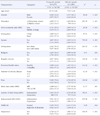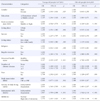Abstract
Purpose
This study was conducted to investigate the prevalence and correlates of depression among community-dwelling older adults (young-old vs old-old) in Korea.
Methods
Data on 11,250 older adults aged 65 or above, from the 2008 National Elderly Survey, were analyzed.
Results
Prevalence rate for depression was greater in old-old people (47.2%) than young-old people (24.7%). The logistic regression analysis revealed that gender, education, socioeconomic status (SES), living place, spouse, regular exercise, perceived health status, number of chronic disease, activity of daily living (ADL), instrumental activity of daily living (IADL), and cognitive function were significantly associated with depression in the young-old. However, in old-old people, education, SES, living status, religion, regular exercise, perceived health status, number of chronic disease, pain, ADL, IADL, and cognitive function were associated with depression.
Figures and Tables
References
1. An JY, Tak YR. Depressive symptoms and related factors in old and oldest-old elderly people witharthritis. J Korean Acad Nurs. 2009. 39:72–83.

2. Choi NG, Kim JS. Age group differences in depressive symptoms among older adults with functional impairments. Health Soc Work. 2007. 32:177–188.

3. Choi YH. A comparative study on health promoting behavior, life satisfaction and self-esteem of the young and old old. J Korean Community Nurs. 2001. 12:428–436.
4. Choi YH. A study on depression, sleep and fatigue in younger and older elders. J Korean Acad Community Health Nurs. 2007. 18:223–231.
5. Jang MH, Won JS. Association of anger and anger expression, social support, self-esteem, and depression in elderly. J Korean Acad Psychiatr Ment Health Nurs. 2009. 18:259–268.
6. Jung YM, Kim JH. Comparison of cognitive levels, nutritional status, depression in the elderly according to living situations. J Korean Acad Nurs. 2004. 34:495–503.

7. Kee BS. A preliminary study for the standardization of geriatric depression scale short form-Korean version. J Korean Neuropsychiatr Assoc. 1996. 35:298–307.
8. Kim MH. The effect of social networks on the health of the Korean elderly: Analysis of Korean longitudinal study of ageing, 2006-2008. 2010. Seoul: Seoul University;Unpublished master's thesis.
9. Lee DY, Lee KU, Lee JH, Kim KW, Ju JH, Yoon JC, et al. A normative study of the mini-mental state examination in the Korean elderly. J Korean Neuropsychiatr Assoc. 2002. 41:508–525.
10. Lee HS, Kim HS, Jung YM. Depression and quality of life in Korean elderly. J Korean Acad Community Health Nurs. 2009. 20:12–22.
11. Lee IJ. A study on the differences between the younger old and the older old: Comparison of the effects of stressful life events and social support on their health. J Korean Gerontol Soc. 1999. 19(3):35–50.
12. Lee PS, Lee YM, Lim JY, Hwang RI, Park EY. The relationship of stress, social support and depression in the elderly. J Korean Acad Nurs. 2004. 34:477–484.

13. Lee SH, Yang SO. The effects of chronic musculoskeletal pain and depression on health-related quality of life by gender in community-dwelling older adults. J Korean Acad Community Health Nurs. 2010. 21:21–30.

14. Lee YH, Shin MH, Kweon SS, Choi SW, Ryu SY, Rhee JA, et al. Prevalence and correlates of depression among the elderly in an urban community. J Agric Med Community Health. 2008. 33:303–315.

15. Luppa M, Sikorski C, Luck T, Weyerer S, Villringer A, Konig HH, et al. Prevalence and risk factors of depressive symptoms in latest life-results of the Leipzig longditudinal Study of aged (LEILA 75+). Int J Geriatr Psychiatry. 2012. 27:286–295.

16. McDougall FA, Matthews FE, Kvaal K, Dewey ME, Brayne C. Prevalence and symptomatology of depression in older people living in institutions in England and Wales. Age Ageing. 2007. 36:562–568.

17. Margrett J, Martin P, Woodard JL, Miller LS, MacDonald M, Baenziger J, et al. Depression among centenarians and the oldest old: Contribution of cognition and personality. Gerontology. 2010. 56:93–99.

18. Mills TL. Comorbid depressive symptomatology: Isolating the effects of chronic medical conditions on self-reported depressive symptoms among community-dwelling older adults. Soc Sci Med. 2001. 53:569–578.

19. Ministry for Health, Welfare and Family Affaires. Establish of new health plan 2010. 2006. Seoul: Author.
20. Negarten B, Moorn J, Low L. Age Norms, Age Constraints, and Adult Socialization. AJS. 1965. 70:710–717.

21. Park EA, Lee IS. Factors affecting the depression of the elderly women in poverty. J Agric Med Community Health. 2009. 34:256–266.

22. Statistics Korea. Population projections for Korea: 2010-2060 (based on the 2010 census). 2011. Daejeon: Author.
23. Stek ML, Gussekloo J, Beekman AT, Van Tilburg W, Westendrop RG. Prevalence, correlates and recognitionof depression in the oldest old: The Leidon 85-plus study. J Affect Disord. 2004. 78:193–200.

24. Stek ML, Vinkers DJ, Gussekloo J, Van Der Mast RC, Beekman AT, Westendorp RG. Natural history of depression in the oldest old: Population-based prospective study. Br J Psychiatry. 2006. 188:65–69.
25. United Nations. World population aging 2009. 2010. Retrieved May 11, 2011. from: http://www.un.org/esa/population/publication/WPA2009/WPA2009-report.pdf.
26. Won CW, Yang KY, Rho YG, Kim SY, Lee EJ, Yoon JL, et al. The development of Korean activities of daily living(K-ADL) and Korean instrumental activities of daily living(K-ADL) Scale. J Korean Geriatr Soc. 2002. 6:107–120.
27. Won JS, Kim JH. Influencing factors on cognitive function and depression in elderly. J Korean Acad Psychiatr Ment Health Nurs. 2003. 12:148–154.




 PDF
PDF ePub
ePub Citation
Citation Print
Print





 XML Download
XML Download